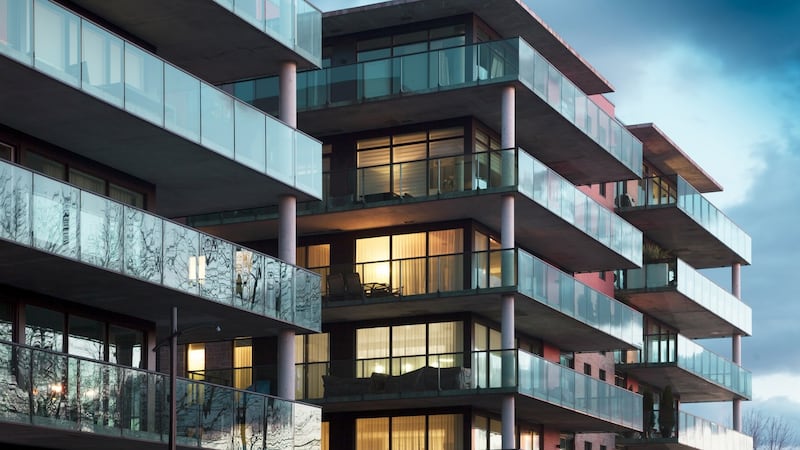City planners have called time on the three-bed semi, signalling that apartment living in the years ahead will be much more the norm. For many singles, couples, small families and downsizers buying this year, an apartment will already be their first choice. But how can you buy the right one?
Who is buying?
The big story around apartments in recent years is "build to rent". This is where entire newly built developments are purchased by an institutional investor for long-term rental. However, units in smaller new schemes don't tend to go this route and with individual landlords exiting the rental market in droves, there are second-hand apartments to be had. A trawl of MyHome.ie shows about 1,200 apartments for sale in Ireland right now, some 700 of them in Dublin.
An apartment makes sense for all kinds of buyers. Affording a house within walking distance of a city’s best restaurants, bars and cultural institutions is a possibility for few. An apartment can provide that same postcode at a fraction of the cost. Many buyers will get lured to a house further out where they can maximise the space for their spend. But for those single, child-free or planning a smaller brood, extra rooms aren’t top of their list.
There is a cohort for whom “the suburbs” is a perceived social and cultural fate to which they will never succumb, or at least not yet. A smaller home but in a prime location is just more them. Work, social life and travel may keep them busy with little extra capacity or interest in tending a larger home.
“Our typical first-time buyer in the city centre last year was 31 years of age and they worked in technology, financial services or in law,” says estate agent and property management agent, Owen Reilly. “Some 55 per cent of those buying on their own were women.”
Downsizers are attracted to apartments too. By selling a large under-used house, they can bag a secure and hassle-free home in a leafy, gated community with spare change for a cruise or lengthy sun holiday every year.
“We have a lot of people in Rathfarnham or Dún Laoghaire who are moving out of bigger houses they don’t need and to free up money for themselves,” says Finbar McDonnell of RF Property Management and Society of Chartered Surveryors Ireland (SCSI) member.

“They settle in very well and it’s often in the same area as their old house so they can use the local church and see their grandchildren. It seems to work very well and is more manageable for them.”
So, if you have your mind set on an apartment, how do you select the best one?
Owing an apartment is different from owning a standalone house. When you buy one, you are buying both the apartment and a share of the ownership of the common areas. You also automatically become a member of the Owners’ Management Company (OMC), a legal structure designed to protect owners’ interests. Owners elect directors from among themselves to manage the development with a management company typically hired to look after the day-to-day jobs, the collection of service charges and keeping accounts.
For this, apartment owners pay an annual service charge. So while living in an apartment means you won’t ever have to fix a roof or mow the lawns yourself, someone has to, and it will be up to you and your co-owners to arrange it between you. A well-run development is apartment living at its best, so do some sleuthing before you buy.
“There is no substitute for going on site and walking around,” says McDonnell. “You can just feel if the development is being well maintained. Is it being painted, is the grass cut, are there nice shrubs, is the gate working? Ask yourself, if I lived here, would I be happy to have my friends around on Saturday night for dinner?”
The state of the bin shed is another telltale sign – is it clean, well maintained and well lit? “The cost of waste removal is a third less in apartment developments with proper recycling,” says Gavin Brangan whose company Access Green specialises in solutions for multi-unit developments. OMCs are responsible for providing segregated waste containers. Getting this right means less of your annual service charge goes in the bin.
Car parking is another factor. “Some developments pre-2000 have a communal set-up where you have a right to park, but don’t have a particular space. It will be first come, first serve,” says McDonnell. If your apartment comes with a space, get the paperwork to prove it and make sure spaces are clearly numbered. Check for visitor parking spaces and ask about plans for electric car charging points too.
For cyclists, secure, well-maintained bike storage will be a priority. “A lot of blocks developed 10 or 15 years ago put in very few bike racks. There are a lot more bikes now, and a lot more bike thieves,” says McDonnell. “Check if the bike stores are secure and if there is enough room in them.”
Visiting the development on different days at different times will tell you whether there is an overflowing bin shed by Thursday, pressure on parking at the weekends or whether kids use your wall to play ball.

Knock on doors and residents may be more than happy to give you the inside track. Perhaps your preferred broadband company doesn’t service the area, or your favourite TV package isn’t a runner because satellite dishes are banned. Ask the estate agent for a copy of the house rules. This will tell you whether pets are allowed, what you can and cannot put on a balcony, and where you can or can’t store a child’s buggy.
The OMC's accounts, accessible via the Companies Registration Office (cro.ie), will give you a look under the bonnet. It may also tell you the age of the development. "Service charge arrears will tell you if people are paying them. If they aren't, it's probably not a great sign," says McDonnell.
A new development may not have much of a sinking fund yet – this is a fund accumulated over time to finance anticipated future capital expenses for the upkeep of the scheme. “In older developments, you’d expect to see more put aside for a rainy day,” he says. It’s worth querying a low sinking fund with the estate agent or the managing agent. If the roof or lifts have just been replaced, it may be money well spent and you, as a new owner, will have dodged the bill. Some Celtic Tiger developments made no provision for a sinking fund and are playing catch-up now. This can mean a levy on top of the annual service charge, says Owen Reilly. By buying into a well-run development, new owners benefit from a sinking fund built up by others over time.
Some will say the greater the number of owner-occupiers in the development, the more likely it is to be well run, but there will always be fewer owners than renters. Tenants dominate apartment living in Ireland. Of apartments in Ireland, about 20 per cent are social rented and 60 per cent are rented privately. The remaining 20 per cent are owner-occupied, according to CSO figures.

Those buying with a mortgage will need a professional survey carried out. While your surveyor will be primarily concerned with your apartment, ask for their views on the overall development too such as the roof type, overall compliance with fire safety regulations, the external plastering and the windows. This may prompt you to seek more specific information. As you are not yet an owner, the management company doesn’t have to share information with you, but they should respond to reasonable questions.
Apartments for many are about affordability and, of course, budget and location are inextricably linked. But buyers beware that in an apartment further out, you may have neither proximity to amenities nor the compensation of extra space. Of the rash of apartments built in the boom of the early 2000s, those who bought furthest out and later wanted to move on have found this home type hardest to shift or rent.
If you’d like the flexibility to move on some day, the location of your apartment will make a difference to its saleability or rentability. But it is possible to score on both price and proximity.
“You can still buy an apartment in pockets close to the city centre for below €300,000, in particular one-beds,” says Reilly. Indeed, you’ll find some two-beds for sub €250,000 within a 15-minute cycle of St Stephen’s Green. Crumlin or Cork Street, with a cycle lane all the way to the city, will tick that box.
In Ringsend, Reilly is selling two-bed apartments for €350,000-€400,000. “You’re close to the city centre, to Sandymount strand, to Grand Canal Dock and to Aviva Stadium and, in a lot of cases, paying the mortgage is cheaper than paying rent. I would say that’s the number one thing motivating first-time buyers.”
Apartments are about lifestyle and ease too. So, in addition to the future, you’ve got to think about your immediate needs. What are the things in your everyday life that bring contentment or frustration, and how could location amplify them? Is walking or cycling to work important rather than getting the bus? Will a couple of great walkable restaurants bring you joy or are there nearby amenities for exercise? These factors, along with your budget, will help you to prioritise locations. A two-bed, two-bathroom apartment in Portobello Dock will provide a prime slice of hipster Dublin 8, within a 10-minute walk of St Stephen’s Green for €360,000. A house in the same area will cost far more.

Ireland has a chequered history when it comes to apartments. That’s probably because we haven’t always done them right. Building standards have come up short and we’ve often built apartments without really thinking about how the inhabitants will live in them. Our neighbours in the EU make far less heavy weather of it. From Barcelona to Berlin, apartment living is common. Nearly 42 per cent of the EU population lives in one. Here, that figure is about 7 per cent.
Population growth means housing in Ireland will have to become more dense to meet demand. Higher density makes public transport, schools, healthcare and policing more efficient. With seven out of 10 households in the State consisting of three people or less, and expected to decline to 2½ people by 2040, according to Government figures, we need to shift to smaller unit sizes and better land use. For city living of the future, if we can get it right, the only way is up.











